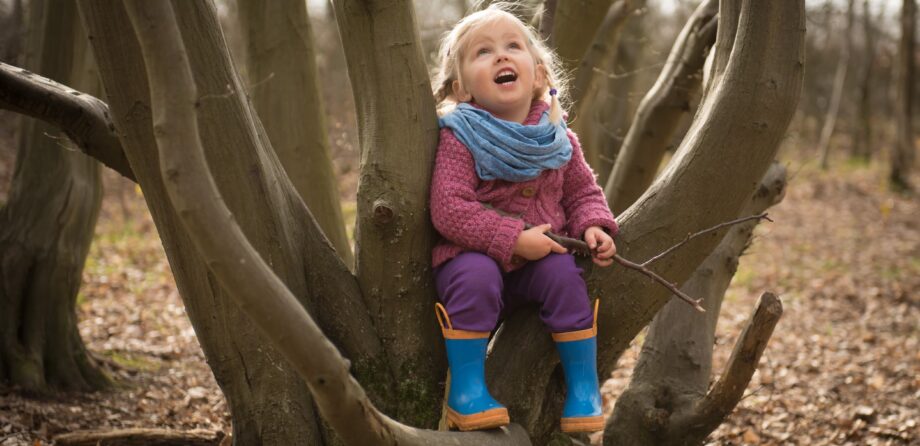
Setting up a nursery forest school
Early years consultant and qualified forest school leader, Tricia Pillay, explores how you can introduce a forest school to your nursery.
Once you have the basics in place for an early years forest school, you will soon notice your children increasing in confidence, developing a ‘have a go’ attitude and persevering when they encounter problems.
What are the benefits of forest school nurseries?
Children hugely benefit from playing and exploring at forest school nurseries:
- Children are growing all the time. The space and freedom for movement available outdoors lets them readily experiment with their increasing size and strength
- In natural environments children can be more in-tune with their senses, so these environments may help them to develop their senses, for example, when children focus their eyes on faraway objects, mimicking the ways in which our hunter ancestors used their eyesight
- Natural outdoor environments support children’s emotional well-being. These environments provide children with the time and space to develop deep thought processes, which helps them to understand the causes and consequences of events in their lives, both the good and the not so good
- Exploring and experimenting outdoors with natural resources puts children in control of their learning, their creativity and their freedom of expression. This enables them to become persistent and persevering learners.
Committing to introducing a forest school to your nursery can seem daunting. But just remember that – as with any other enterprise – starting too big and expecting too much, too soon, can be a recipe for disaster.
Where to start when setting up a nursery forest school?
While you may be aiming for a time when your children will enthusiastically and safely launch into exploring and experimenting with your early years forest school, that is not your beginning point. You should begin by building the confidence of both practitioners and children.
Building practitioner confidence
Talk to practitioners about their concerns and fears. You can plan together to address these by talking through possible scenarios and the actions to take.
Make sure you practice and prepare. You could perhaps start by taking out small groups to play the safety game.
You could also try to visit other nursery forest schools that are already well-established. Agree on clear expectations with practitioners. Keep to these consistently and remember that practitioner confidence may build slowly. Talk about successes to reinforce developing confidence.
Building children’s confidence
Establish clear expectations and keep to these consistently.
Let your children make decisions about the risks they are comfortable with. For example, rather than lifting a child onto a log or tree, let them climb independently when they feel confident to do so.
Remember, your children do not want to get lost or hurt. Help them to take responsibility for their own actions by using language that gets them thinking and planning for themselves, rather than just following instructions.
Children’s confidence builds through their positive experiences. This will be a slower process for some children, give them time.
“It’s definitely worthwhile getting the basics right from the start. Two essential basics are, of course, safety and comfort.”
Safety when setting up a nursery forest school
Safety, of course, should be paramount. Here are a few things to consider, alongside policies and procedures you have in place:
- Take a fully charged mobile phone and make sure that you have up-to-date contact details for parents/carers
- Take a first aid kit, including unopened bottled water for washing any wounds
- Make sure that all staff have up-to-date first aid training and know how to respond to the types of accident or injury they may encounter outdoors (take a look at NDNA’s Millie’s Mark scheme, the gold standard in paediatric first aid)
- Make sure that practitioners can alert each other quickly should they need help – such as by each carrying a whistle
- Have a call, signal or sound that all children know, that you can use when children need to return to an agreed meeting point – this might be in an emergency or when it is time to leave
- Don’t be tempted to undertake advanced activities – such as making fires – until practitioners are confident, and you have done lots of preparatory work with children.
‘There’s no such thing as bad weather, only unsuitable clothing’
Both practitioners and children need to be able to explore and experiment freely and in all types of weather!
They can’t do that if they are worried about getting clothes dirty, spoiling shoes, or if they are too cold, too hot, or wet. Put plans in place to deal with these issues right from the start.
Probably the most important investment I have ever made in setting up an early years forest school was the provision of warm fleeces, thermal socks, waterproof trousers and jackets for children and practitioners.
Ask parents if they could provide wellies, not all parents will – or be able to do so – but you will find that you quickly build up a supply of spare wellies as parents leave their children’s outgrown wellies with you.
Build up a supply of spare tights and/or leggings that children can wear under their trousers in cold weather.
Gloves will get wet and muddy, it’s well worth having lots of gloves available and taking spares with you in very cold weather.
Children will need sunhats in summer and warm hats in winter.
Wearing waterproof jackets and trousers in all but the very hottest weather will ensure that children can explore without fear of scratches and stings, sit comfortably on the ground and not have to worry about keeping their clothes clean.
Parents will be delighted not to have muddy clothes sent home. It’s great to watch the amazement on the face of a three-year-old as they peel off soggy waterproofs and exclaim, ‘my clothes are all dry’!
Nursery forest school ‘Safety Game’ activity:
- Sit in a circle. Circles allow everyone to immediately see everyone else. It’s useful to consistently have practitioners and children sitting in a circle for games, stories, talking, planning and, eventually, fire lighting and cooking
- Give each child a flag or other marker
- In turn, send each of the children to place their marker. Have a child stand with their back to the circle and walk away from the group
- At short intervals ask, ‘can you still hear me?’ making your voice quieter as the child gets further away
- When the child can no longer hear you, have them place their marker and return to the circle.
With this activity, children are walking away from the group, thinking that nobody is watching them. Even the most confident children will not go far.
If you do have a child that you believe may not come back, you will need to ensure that a member of staff is quickly able to follow them and bring them calmly back to the circle.

This blog post was written by Tricia Pillay, early years consultant and qualified forest school leader.
- child confidence
- developing confidence
- early years
- forest school
Similar Articles
The UNCRC (Incorporation) (Scotland) Act 2024 – What does it mean for nurseries?

Safe sleep in nurseries

